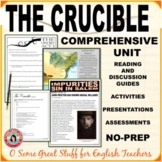The Crucible Arthur Miller's "Why I Wrote The Crucible" Article and Questions
- PDF
- Easel Activity
What educators are saying
Also included in
- This complete, no-prep comprehensive unit for Arthur Miller's play, The Crucible includes reading and discussion guides, formal and creative assessments, activities, and presentations to engage your high school ELA students as they study American literature, modern drama, investigate history includPrice $60.00Original Price $74.75Save $14.75
Description
Enhance your high school ELA students' critical reading skills with this interesting pre-reading activity for Arthur Miller's modern play, The Crucible, Miller's article "Why I Wrote The Crucible" and questions for students. Includes detailed answer key. No prep.
In October of 1996, to celebrate the 50th anniversary of The Crucible, Arthur Miller wrote an essay for the New Yorker titled, “Why I Wrote The Crucible.” In this article, he recounts the terror of the Red Scare led by Senator Joseph McCarthy, the effect the hunt for communists had on America, and the motivation it gave him to write his allegorical play, The Crucible. He discusses his research on the Salem Witch Trials. He eloquently describes the parallels he established between the McCarthy hearings of the 1950s and Witch Trials in Massachusetts in the 1690s. Throughout the essay, Miller uses engaging figurative language and compelling diction as he reveals his discoveries about human nature and the impact of society’s ideology on its citizens.
Printable PDF or TPT Digital Easel Activity
This resource includes:
- The complete text of the essay highlighted to correspond with questions.
- 50 questions requiring higher-order thinking skills
- Questions task students with rewording Miller’s remarks, identifying and discussing the effectiveness of figurative language, responding to reading comprehension prompts, and more.
- One graphic, a photo of Miller.
- An identical answer key with detailed responses
Clear font
Space for students’ responses.
A buyer commented: "The Crucible is one of my very favorite units. I love being able to give the history behind this play."
Please have a look at the preview.
Thank you for your consideration of this resource.
To explore other resources for teaching The Crucible, click below:
Related Products:
COLONIAL AMERICA, PURITANISM, AND THE CRUCIBLE Introduction Presentation
THE CRUCIBLE UNIT BUNDLE Comprehension, Analysis, Creativity, Collaboration
The Crucible, McCarthyism, and Salem Witch Trials Researched Speech Introduction
____________________________________________
Don’t forget to leave a review to earn credit toward future purchases.
Connect with me…
To follow my store and receive notifications
about new resources and store sales, click below:
O SOME GREAT STUFF FOR ENGLISH TEACHERS TPT STORE
Follow me anywhere and everywhere…
Subscribe to my monthly newsletter AND receive a valuable
free resource; click below:
Have a pleasant day!
Lori O







